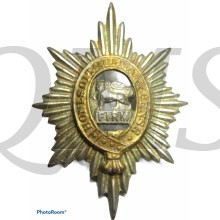Cap badge The Worcestershire Regiment, other ranks
Badge of the pattern worn 1925 to 1958. The predecessor Regiment was formed in London in 1694 as Thomas Farrington’s Regiment of Foot, Farrington being an officer in the Coldstream Guards. The Regiment was on a number of subsequent occasions commanded by officers from the same source. The Garter Star device that was to feature in the cap badges in various forms during the life of the Regiment, and later the Garter itself, probably both derive from this association. Although the first unit was reduced to officer cadre strength in 1698 it was reformed in 1702 and in 1747and was ranked as 29th Foot, being formally known as such from 1751. It had served as Marines between 1740 and 1742, and would do so again between 1793 and 1797. In 1782 the Regiment was re-designated as the 29th (The Worcestershire) Regiment of Foot. In the Cardwell reforms of 1881 the Regiment merged with the 36th Foot (Herefordshire) to form the Worcestershire Regiment. The cap badge at this time took the star device from the 29th and the motto, FIRM, from the 36th, believed to have been awarded to them for their service at the Battle of Lauffield, 1747, although not displayed on the colours until 1773. The introduction of the field service cap in 1898 required a re-design and the Garter and the Lion (an old badge of the 29th) were introduced to the centre of the badge. A further design change occurred in 1925, when the star became elongated vertically, and the motto FIRM was brought into the centre of the badge as a tablet on which stood the lion. The strap at the Garter buckle was replaced by a representation of three pears, a symbol drawn from the arms of the City of Worcester, and representing the county perry orchards, a major local industry. In 1958 the Regiment became part of the Mercian Brigade, at which time the regular battalions were expected to wear the Brigade badge. In 1970 the Brigade was broken up and in February of that year the Worcester and Sherwood Forester elements merged to form the Worcester and Sherwood Foresters Regiment. The new cap badge managed to combine the main elements of both the parent Regiments’ badges. In 2007 the Mercian Regiment was formed and the Worcester and Foresters Regiment became its second battalion.



